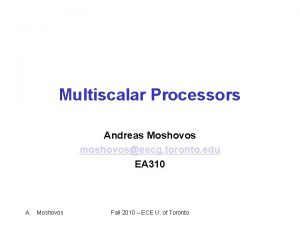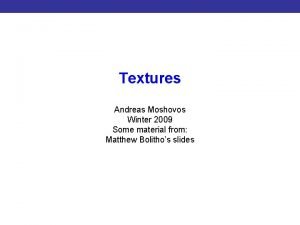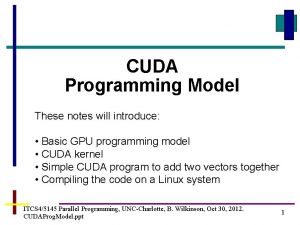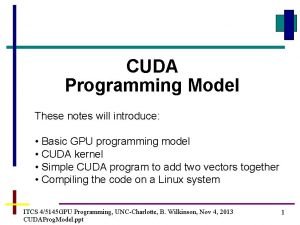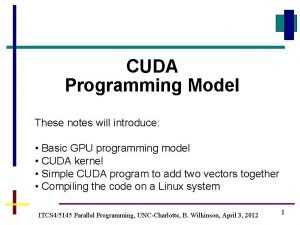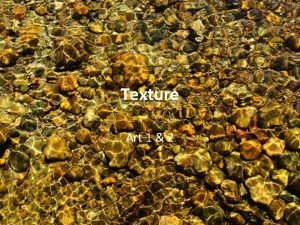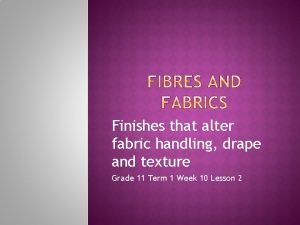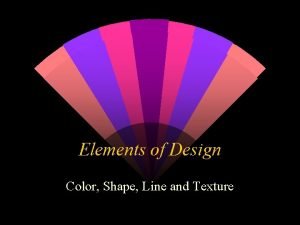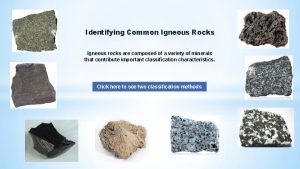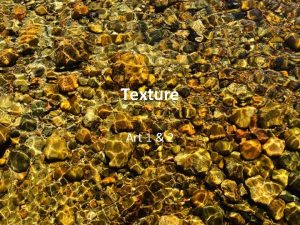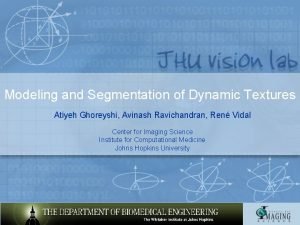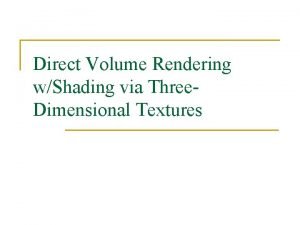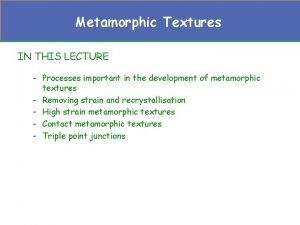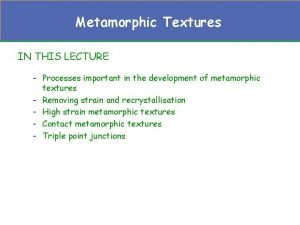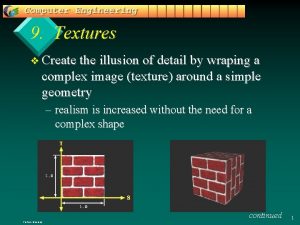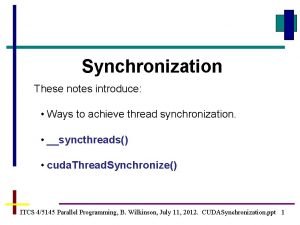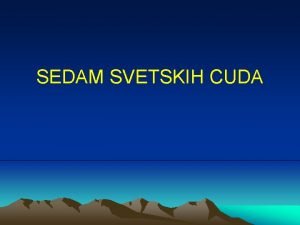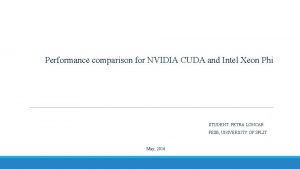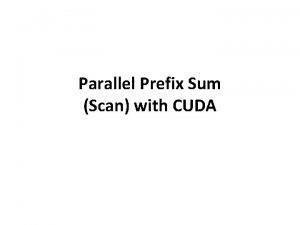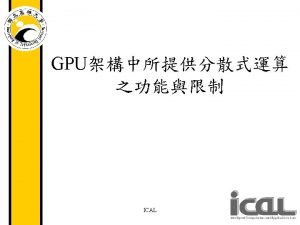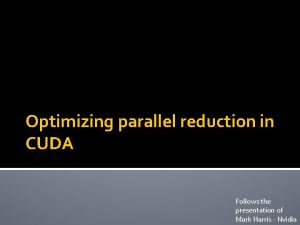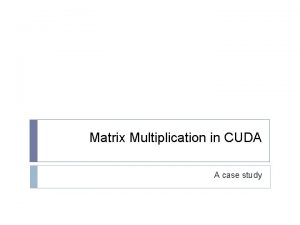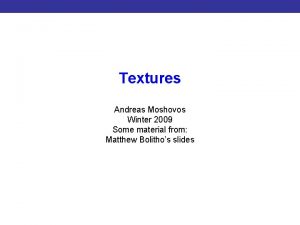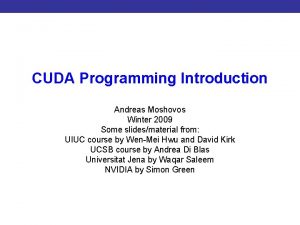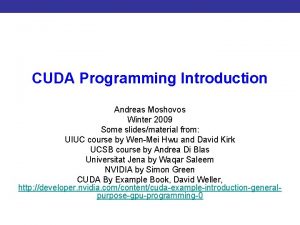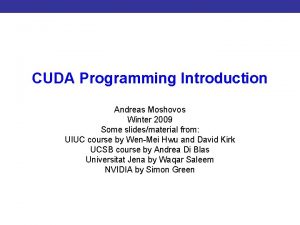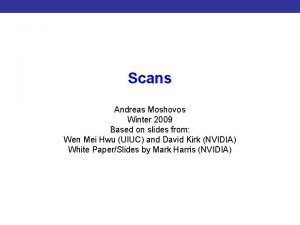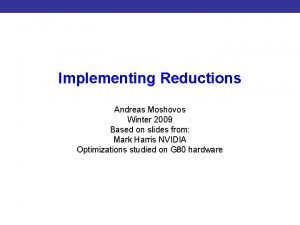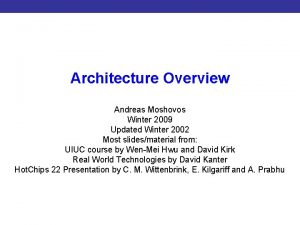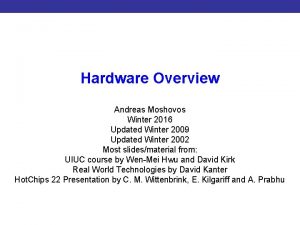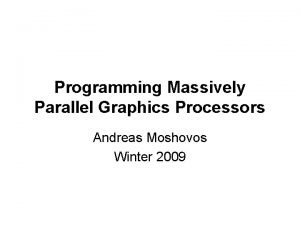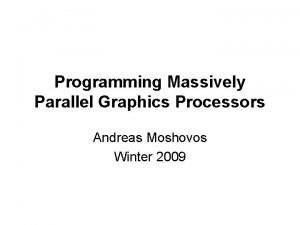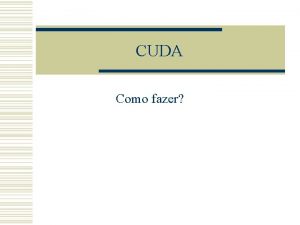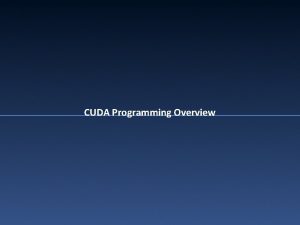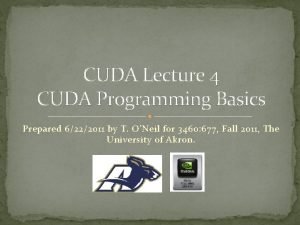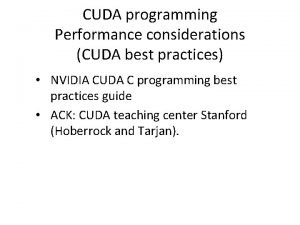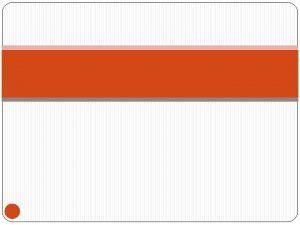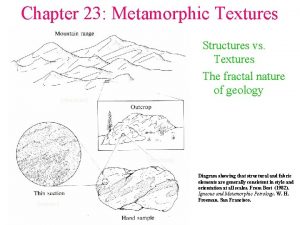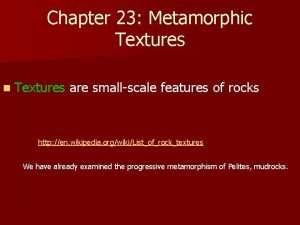Textures Introduction to CUDA Programming Andreas Moshovos Winter



































- Slides: 35

Textures Introduction to CUDA Programming Andreas Moshovos Winter 2009 Some material from: Matthew Bolitho’s slides

Memory Hierarchy overview • Registers – Very fast • Shared Memory – Very Fast • Local Memory – 400 -600 cycles • Global Memory – 400 -600 cycles • Constant Memory – 400 -600 cycles • Texture Memory – 400 -600 cycles – 8 K Cache

What is Texture Memory • A block of read-only memory shared by all multiprocessors – 1 D, 2 D, or 3 D array – Texels: Up to 4 -element vectors – x, y, z, w • Reads from texture memory can be “samples” of multiple texels • Slow to access – several hundred clock cycle latency • But it is cached: – 8 KB per multi-processor – Fast access if cache hit • Good if you have random accesses to a large readonly data structure

Overview: Benefits & Limitations of CUDA textures • Texture fetches are cached – Optimized for 2 D locality • We’ll talk about this at the end • Addressing: – 1 D, 2 D, or 3 D • Coordinates: – integer or normalized – Fewer addressing calculations in code • Provide filtering for free • Free out-of-bounds handling: wrap modes – Clamp to edge / warp • Limitations of CUDA textures: – Read-only from within a kernel

Texture Abstract Structure • A 1 D, 2 D, or 3 D array. • Example 4 x 4: Values assigned by the program

Regular Indexing • Indexes are floating point numbers – Think of the texture as a surface as opposed to a grid for which you have a grid of samples Not there

Normalized Indexing • Nx. M Texture: – [0, 1. 0) x [0. 0, 1. 0) indexes (0. 0, 0. 0) (0. 5, 0, 5) (1. 0, 1. 0) Convenient if you want to express the computation in size-independent terms

What Value Does a Texture Reference Return? • Nearest-Point Sampling – Comes for “free” – Elements must be floats

Nearest-Point Sampling • In this filtering mode, the value returned by the texture fetch is – tex(x) = T[i] for a one-dimensional texture, – tex(x, y) = T[i, j] for a two-dimensional texture, – tex(x, y, z) = T[i, j, k] for a three-dimensional texture, • where i = floor(x) , j = floor( y) , and k = floor(z).

Nearest-Point Sampling: 4 -Element 1 D Texture Behaves more like a conventional array

Another Filtering Option • Linear Filtering See Appendix D of the Programming Guide

Linear-Filtering Detail Good luck with this one: Effectively the value read is a weighted average of all neighboring texels

Linear-Filtering: 4 -Element 1 D Texture

Dealing with Out-of-Bounds References • Clamping – Get’s stuck at the edge • i < 0 actual i = 0 • i > N -1 actual i = N -1 • Warping – Warps around • actual i = i MOD N • Useful when texture is a periodic signal

Texture Addressing Explained

Texels • Texture Elements – All elemental datatypes • Integer, char, short, float (unsigned) – CUDA vectors: 1, 2, or 4 elements • • • char 1, uchar 1, char 2, uchar 2, char 4, uchar 4, short 1, ushort 1, short 2, ushort 2, short 4, ushort 4, int 1, uint 1, int 2, uint 2, int 4, uint 4, long 1, ulong 1, long 2, ulong 2, long 4, ulong 4, float 1, float 2, float 4,

Programmer’s view of Textures • Texture Reference Object – Use that to access the elements – Tells CUDA what the texture looks like • Space to hold the values – Linear Memory (portion of memory) • Only for 1 D textures – CUDA Array • Special CUDA Structure used for Textures – Opaque • Then you bind the two: – Space and Reference

Texture Reference Object – texture<Type, Dim, Read. Mode> tex. Ref; • Type = texel datatype • Dim = 1, 2, 3 • Read. Mode: – What values are returned • cuda. Read. Mode. Element. Type – Just the elements What you write is what you get • cuda. Read. Mode. Normalized. Float – Works for chars and shorts (unsigned) – Value normalized to [0. 0, 1. 0]

CUDA Containers: Linear Memory • Bound to linear memory – Global memory is bound to a texture • Cuda. Malloc() – Only 1 D – Integer addressing – No filtering, no addressing modes – Return either element type or normalized float

CUDA Containers: CUDA Arrays • Bound to CUDA arrays – CUDA array is bound to a texture – 1 D, 2 D, or 3 D – Float addressing • size-based, normalized – Filtering – Addressing modes • clamping, warping – Return either element type or normalized float

CUDA Texturing Steps • Host (CPU) code: – Allocate/obtain memory • global linear, or CUDA array – Create a texture reference object • Currently must be at file-scope – Bind the texture reference to memory/array – When done: • Unbind the texture reference, free resources • Device (kernel) code: – Fetch using texture reference – Linear memory textures: • tex 1 Dfetch() – Array textures: • tex 1 D(), tex 2 D(), tex 3 D()

Texture Reference Parameters • Immutable parameters compile-time • Specified at compile time – Type: texel type • Basic int, float types • CUDA 1 -, 2 -, 4 -element vectors – Dimensionality: • 1, 2, or 3 – Read Mode: • cuda. Read. Mode. Element. Type • cuda. Read. Mode. Normalized. Float – valid for 8 - or 16 -bit ints – returns [-1, 1] for signed, [0, 1] for unsigned

Texture Reference Mutable Parameters • Mutable parameters • Can be changed at run-time – only for array-textures – Normalized: • non-zero = addressing range [0, 1] – Filter Mode: • cuda. Filter. Mode. Point • cuda. Filter. Mode. Linear – Address Mode: • cuda. Address. Mode. Clamp • cuda. Address. Mode. Wrap

Example: Linear Memory // declare texture reference (must be at file-scope) Texture<unsigned short, 1, cuda. Read. Mode. Normalized. Float> tex. Ref; // Type, Dimensions, return value normalization // set up linear memory on Device unsigned short *d. A = 0; cuda. Malloc ((void**)&d. A, num. Bytes); // Copy data from host to device cuda. Mempcy(d. A, h. A, num. Bytes, cuda. Memcpy. Host. To. Device); // bind texture reference to array cuda. Bind. Texture(NULL, tex. Ref, d. A, size /* in bytes */);

How to Access Texels In Linear Memory Bound Textures • Type tex 1 Dfetch(tex. Ref, int x); • Where Type is the texel datatype • Previous example: – Unsigned short value = tex 1 Dfetch (tex. Ref, 10) – Returns element 10

CUDA Array Type • Channel format, width, height • cuda. Channel. Format. Desc structure – int x, y, z, w: parts for each component – enum cuda. Channel. Format. Kind – one of: • cuda. Channel. Format. Kind. Signed • cuda. Channel. Format. Kind. Unsigned • cuda. Channel. Format. Kind. Float – Some predefined constructors: • cuda. Create. Channel. Desc<float>(void); • cuda. Create. Channel. Desc<float 4>(void); • Management functions: – cuda. Malloc. Array, cuda. Free. Array, – cuda. Memcpy. To. Array, cuda. Memcpy. From. Array, . . .

Example Host Code for 2 D array // declare texture reference (must be at file-scope) Texture<float, 2, cuda. Read. Mode. Element. Type> tex. Ref; // set up the CUDA array cuda. Channel. Format. Desc cf = cuda. Create. Channel. Desc<float>(); cuda. Array *tex. Array = 0; cuda. Malloc. Array(&tex. Array, &cf, dim. X, dim. Y); cuda. Mempcy. To. Array(tex. Array, 0, 0, h. A, num. Bytes, cuda. Memcpy. Host. To. Device); // specify mutable texture reference parameters tex. Ref. normalized = 0; tex. Ref. filter. Mode = cuda. Filter. Mode. Linear; tex. Ref. address. Mode = cuda. Address. Mode. Clamp; // bind texture reference to array cuda. Bind. Texture. To. Array(tex. Ref, tex. Array);

Accessing Texels • Type tex 1 D(tex. Ref, float x); • Type tex 2 D(tex. Ref, float x, float y); • Type tex 3 D(tex. Ref, float x, float y, float z);

At the end • cuda. Unbind. Texture (tex. Ref)

Dimension Limits • In Elements not bytes – In CUDA Arrays: • 1 D: 8 K • 2 D: 64 K x 32 K • 3 D: 2 K x 2 K – If in linear memory: 2^27 • That’s 128 M elements • Floats: – 128 M x 4 = 512 MB • Not verified: • Info from: Cyril Zeller of NVIDIA – http: //forums. nvidia. com/index. php? showtopic=29545 &view=findpost&p=169592

Textures are Optimized for 2 D Locality • Regular Array Allocation – Row-Major • Because of Filtering – Neighboring texels – Accessed close in time

Textures are Optimized for 2 D Locality

Using Textures • Textures are read-only – Within a kernel • A kernel can produce an array – Cannot write CUDA Arrays • Then this can be bound to a texture for the next kernel • Linear Memory can be copied to CUDA Arrays – cuda. Memcpy. From. Array() • Copies linear memory array to a Cuda. Array – cuda. Memcpy. To. Array() • Copies Cuda. Array to linear memory array

An Example • http: //www. mmm. ucar. edu/wrf/WG 2/GPU/Scala r_Advect. htm • GPU Acceleration of Scalar Advection

Cuda Arrays • Read the CUDA Reference Manual • Relevant functions are the ones with “Array” in it • Remember: – Array format is opaque • Pitch: – Padding added to achieve good locality – Some functions require this pitch to be passed as a an argument – Prefer those that use it from the Array structure directly
 Andreas moshovos
Andreas moshovos Cuda texture
Cuda texture Cuda programming model
Cuda programming model Cuda programming model
Cuda programming model Cuda
Cuda Cuda programming model
Cuda programming model Winter kommt winter kommt flocken fallen nieder
Winter kommt winter kommt flocken fallen nieder Winter kommt winter kommt flocken fallen nieder
Winter kommt winter kommt flocken fallen nieder Meine lieblingsjahreszeit ist der winter
Meine lieblingsjahreszeit ist der winter Invented textures
Invented textures Textures drape fabric
Textures drape fabric What elements of design are stiff, rough, shiny and smooth?
What elements of design are stiff, rough, shiny and smooth? Partially resident textures
Partially resident textures Rock textures chart
Rock textures chart Texture actual
Texture actual Atiyeh ghoreyshi
Atiyeh ghoreyshi Rendering fur with three dimensional textures
Rendering fur with three dimensional textures Grain rotation
Grain rotation Metamorphic textures
Metamorphic textures What are textures
What are textures Illusion textures
Illusion textures Perbedaan linear programming dan integer programming
Perbedaan linear programming dan integer programming Greedy algorithm vs dynamic programming
Greedy algorithm vs dynamic programming Runtime programming
Runtime programming Linear vs integer programming
Linear vs integer programming Perbedaan linear programming dan integer programming
Perbedaan linear programming dan integer programming Texture memory cuda
Texture memory cuda Cuda critical section
Cuda critical section Sedam svetskih cuda
Sedam svetskih cuda Nvidia cuda comparison
Nvidia cuda comparison Exclusive scan cuda
Exclusive scan cuda Rbg pixel
Rbg pixel Parallel reduction cuda
Parallel reduction cuda Optimizing parallel reduction in cuda
Optimizing parallel reduction in cuda Matrix multiplication cuda
Matrix multiplication cuda Alisa u zemlji čudesa likovi
Alisa u zemlji čudesa likovi
